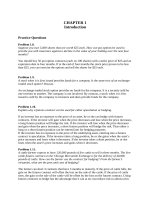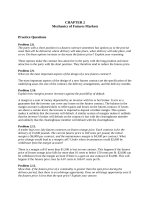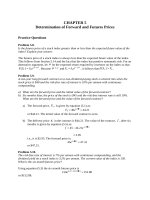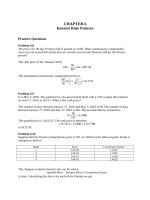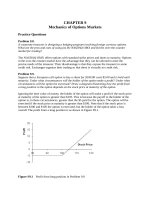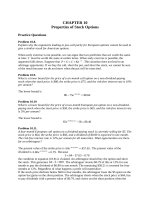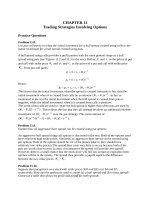Solutions fundamentals of futures and options markets 7e by hull chapter 05
Bạn đang xem bản rút gọn của tài liệu. Xem và tải ngay bản đầy đủ của tài liệu tại đây (123.91 KB, 9 trang )
CHAPTER 5
Determination of Forward and Futures Prices
Practice Questions
Problem 5.8.
Is the futures price of a stock index greater than or less than the expected future value of the
index? Explain your answer.
The futures price of a stock index is always less than the expected future value of the index.
This follows from Section 5.14 and the fact that the index has positive systematic risk. For an
alternative argument, let be the expected return required by investors on the index so that
E ( ST ) S0 e( q )T . Because r and F0 S 0e( r q )T , it follows that E ( ST ) F0 .
Problem 5.9.
A one-year long forward contract on a non-dividend-paying stock is entered into when the
stock price is $40 and the risk-free rate of interest is 10% per annum with continuous
compounding.
a) What are the forward price and the initial value of the forward contract?
b) Six months later, the price of the stock is $45 and the risk-free interest rate is still 10%.
What are the forward price and the value of the forward contract?
a) The forward price, F0 , is given by equation (5.1) as:
F0 40e01�1 4421
or $44.21. The initial value of the forward contract is zero.
b) The delivery price K in the contract is $44.21. The value of the contract, f , after six
months is given by equation (5.5) as:
f 45 4421e 01�05
295
i.e., it is $2.95. The forward price is:
45e 01�05 4731
or $47.31.
Problem 5.10.
The risk-free rate of interest is 7% per annum with continuous compounding, and the
dividend yield on a stock index is 3.2% per annum. The current value of the index is 150.
What is the six-month futures price?
Using equation (5.3) the six month futures price is
150e(007 0032)�05 15288
or $152.88.
Problem 5.11.
Assume that the risk-free interest rate is 9% per annum with continuous compounding and
that the dividend yield on a stock index varies throughout the year. In February, May, August,
and November, dividends are paid at a rate of 5% per annum. In other months, dividends are
paid at a rate of 2% per annum. Suppose that the value of the index on July 31 is 1,300. What
is the futures price for a contract deliverable on December 31 of the same year?
The futures contract lasts for five months. The dividend yield is 2% for three of the months
and 5% for two of the months. The average dividend yield is therefore
1
(3 �2 2 �5) 32%
5
The futures price is therefore
1300e(0090032)�04167 1 33180
or $1331.80.
Problem 5.12.
Suppose that the risk-free interest rate is 10% per annum with continuous compounding and
that the dividend yield on a stock index is 4% per annum. The index is standing at 400, and
the futures price for a contract deliverable in four months is 405. What arbitrage
opportunities does this create?
The theoretical futures price is
400e(010004)�4 12 40808
The actual futures price is only 405. This shows that the index futures price is too low relative
to the index. The correct arbitrage strategy is
1.
Buy futures contracts
1.
Short the shares underlying the index.
Problem 5.13.
Estimate the difference between short-term interest rates in Japan and the United States on
August 4, 2009 from the information in Table 5.4.
The settlement prices for the futures contracts are to
Sept: 1.0502
Dec: 1.0512
The December 2009 price is about 0.0952% above the September 2009 price. This suggests
that the short-term interest rate in the United States exceeded short-term interest rate in the
United Japan by about 0.0952% per three months or about 0.38% per year.
Problem 5.14.
The two-month interest rates in Switzerland and the United States are 2% and 5% per
annum, respectively, with continuous compounding. The spot price of the Swiss franc is
$0.8000. The futures price for a contract deliverable in two months is $0.8100. What
arbitrage opportunities does this create?
The theoretical futures price is
08000e (005002)�2 12 08040
The actual futures price is too high. This suggests that an arbitrageur should buy Swiss francs
and short Swiss francs futures.
Problem 5.15.
The current price of silver is $15 per ounce. The storage costs are $0.24 per ounce per year
payable quarterly in advance. Assuming that interest rates are 10% per annum for all
maturities, calculate the futures price of silver for delivery in nine months.
The present value of the storage costs for nine months are
006 006e 010�025 006e 010�05 0176
or $0.176. The futures price is from equation (5.11) given by F0 where
F0 (15000 0176)e01�075 1636
i.e., it is $16.36 per ounce.
Problem 5.16.
Suppose that F1 and F2 are two futures contracts on the same commodity with times to
maturity, t1 and t2 , where t2 t1 . Prove that
F2 �F1e r ( t2 t1 )
where r is the interest rate (assumed constant) and there are no storage costs. For the
purposes of this problem, assume that a futures contract is the same as a forward contract.
If
F2 F1er (t2 t1 )
an investor could make a riskless profit by
1.
Taking a long position in a futures contract which matures at time t1
2.
Taking a short position in a futures contract which matures at time t2
When the first futures contract matures, the asset is purchased for F1 using funds borrowed at
rate r . It is then held until time t2 at which point it is exchanged for F2 under the second
r ( t t )
contract. The costs of the funds borrowed and accumulated interest at time t2 is F1e 2 1 . A
positive profit of
F2 F1e r (t2 t1 )
is then realized at time t2 . This type of arbitrage opportunity cannot exist for long. Hence:
F2 �F1e r ( t2 t1 )
Problem 5.17.
When a known future cash outflow in a foreign currency is hedged by a company using a
forward contract, there is no foreign exchange risk. When it is hedged using futures
contracts, the daily settlement process does leave the company exposed to some risk. Explain
the nature of this risk. In particular, consider whether the company is better off using a
futures contract or a forward contract when
a)
b)
c)
d)
The value of the foreign currency falls rapidly during the life of the contract
The value of the foreign currency rises rapidly during the life of the contract
The value of the foreign currency first rises and then falls back to its initial value
The value of the foreign currency first falls and then rises back to its initial value
Assume that the forward price equals the futures price.
In total the gain or loss under a futures contract is equal to the gain or loss under the
corresponding forward contract. However the timing of the cash flows is different. When the
time value of money is taken into account a futures contract may prove to be more valuable
or less valuable than a forward contract. Of course the company does not know in advance
which will work out better. The long forward contract provides a perfect hedge. The long
futures contract provides a slightly imperfect hedge.
a) In this case the forward contract would lead to a slightly better outcome. The company
will make a loss on its hedge. If the hedge is with a forward contract the whole of the loss
will be realized at the end. If it is with a futures contract the loss will be realized day by
day throughout the contract. On a present value basis the former is preferable.
b) In this case the futures contract would lead to a slightly better outcome. The company will
make a gain on the hedge. If the hedge is with a forward contract the gain will be realized
at the end. If it is with a futures contract the gain will be realized day by day throughout
the life of the contract. On a present value basis the latter is preferable.
c) In this case the futures contract would lead to a slightly better outcome. This is because it
would involve positive cash flows early and negative cash flows later.
d) In this case the forward contract would lead to a slightly better outcome. This is because,
in the case of the futures contract, the early cash flows would be negative and the later
cash flow would be positive.
Problem 5.18.
It is sometimes argued that a forward exchange rate is an unbiased predictor of future
exchange rates. Under what circumstances is this so?
From the discussion in Section 5.14 of the text, the forward exchange rate is an unbiased
predictor of the future exchange rate when the exchange rate has no systematic risk. To have
no systematic risk the exchange rate must be uncorrelated with the return on the market.
Problem 5.19.
Show that the growth rate in an index futures price equals the excess return of the portfolio
underlying the index over the risk-free rate. Assume that the risk-free interest rate and the
dividend yield are constant.
Suppose that F0 is the futures price at time zero for a contract maturing at time T and F1 is
the futures price for the same contract at time t1 . It follows that
F0 S0e( r q )T
F1 S1e ( r q )(T t1 )
where S 0 and S1 are the spot price at times zero and t1 , r is the risk-free rate, and q is the
dividend yield. These equations imply that
F1 S1 ( r q ) t1
e
F0 S0
Define the excess return of the portfolio underlying the index over the risk-free rate as x . The
total return is r x and the return realized in the form of capital gains is r x q . It follows
( r x q ) t1
that S1 S 0e
and the equation for F1 F0 reduces to
F1
e xt1
F0
which is the required result.
Problem 5.20.
Show that equation (5.3) is true by considering an investment in the asset combined with a
short position in a futures contract. Assume that all income from the asset is reinvested in the
asset. Use an argument similar to that in footnotes 2 and 4 and explain in detail what an
arbitrageur would do if equation (5.3) did not hold.
Suppose we buy N units of the asset and invest the income from the asset in the asset. The
income from the asset causes our holding in the asset to grow at a continuously compounded
rate q . By time T our holding has grown to Ne qT units of the asset. Analogously to
footnotes 2 and 4 of Chapter 5, we therefore buy N units of the asset at time zero at a cost of
S 0 per unit and enter into a forward contract to sell Ne qT unit for F0 per unit at time T . This
generates the following cash flows:
NS0
Time 0:
NF0 e qT
Time 1:
Because there is no uncertainty about these cash flows, the present value of the time T
inflow must equal the time zero outflow when we discount at the risk-free rate. This means
that
NS0 ( NF0e qT )e rT
or
F0 S0 e( r q )T
This is equation (5.3).
( r q )T
If F0 S 0e
, an arbitrageur should borrow money at rate r and buy N units of the asset.
At the same time the arbitrageur should enter into a forward contract to sell Ne qT units of the
asset at time T . As income is received, it is reinvested in the asset. At time T the loan is
qT
rT
repaid and the arbitrageur makes a profit of N ( F0 e S0 e ) at time T .
( r q )T
If F0 S0 e
, an arbitrageur should short N units of the asset investing the proceeds at
rate r . At the same time the arbitrageur should enter into a forward contract to buy Ne qT
units of the asset at time T . When income is paid on the asset, the arbitrageur owes money
on the short position. The investor meets this obligation from the cash proceeds of shorting
further units. The result is that the number of units shorted grows at rate q to Ne qT . The
cumulative short position is closed out at time T and the arbitrageur makes a profit of
N ( S 0e rT F0 e qT ) .
Problem 5.21.
Explain carefully what is meant by the expected price of a commodity on a particular future
date. Suppose that the futures price of crude oil declines with the maturity of the contract at
the rate of 2% per year. Assume that speculators tend to be short crude oil futures and
hedgers tended to be long crude oil futures. What does the Keynes and Hicks argument imply
about the expected future price of oil?
To understand the meaning of the expected future price of a commodity, suppose that there
are N different possible prices at a particular future time: P1 , P2 , …, PN . Define qi as the
(subjective) probability the price being Pi (with q1 q2 … qN 1 ). The expected future
price is
N
�q P
i 1
i i
Different people may have different expected future prices for the commodity. The expected
future price in the market can be thought of as an average of the opinions of different market
participants. Of course, in practice the actual price of the commodity at the future time may
prove to be higher or lower than the expected price.
Keynes and Hicks argue that speculators on average make money from commodity futures
trading and hedgers on average lose money from commodity futures trading. If speculators
tend to have short positions in crude oil futures, the Keynes and Hicks argument implies that
futures prices overstate expected future spot prices. If crude oil futures prices decline at 2%
per year the Keynes and Hicks argument therefore implies an even faster decline for the
expected price of crude oil if speculators are short.
Problem 5.22.
The Value Line Index is designed to reflect changes in the value of a portfolio of over 1,600
equally weighted stocks. Prior to March 9, 1988, the change in the index from one day to the
next was calculated as the geometric average of the changes in the prices of the stocks
underlying the index. In these circumstances, does equation (5.8) correctly relate the futures
price of the index to its cash price? If not, does the equation overstate or understate the
futures price?
When the geometric average of the price relatives is used, the changes in the value of the
index do not correspond to changes in the value of a portfolio that is traded. Equation (5.8) is
therefore no longer correct. The changes in the value of the portfolio are monitored by an
index calculated from the arithmetic average of the prices of the stocks in the portfolio. Since
the geometric average of a set of numbers is always less than the arithmetic average, equation
(5.8) overstates the futures price. It is rumored that at one time (prior to 1988), equation (5.8)
did hold for the Value Line Index. A major Wall Street firm was the first to recognize that this
represented a trading opportunity. It made a financial killing by buying the stocks underlying
the index and shorting the futures.
Further Questions
Problem 5.23
An index is 1,200. The three-month risk-free rate is 3% per annum and the dividend yield
over the next three months is 1.2% per annum. The six-month risk-free rate is 3.5% per
annum and the dividend yield over the next six months is 1% per annum. Estimate the futures
price of the index for three-month and six-month contracts. All interest rates and dividend
yields are continuously compounded.
The futures price for the three month contract is 1200e(0.03-0.012)×0.25 =1205.41. The futures price
for the six month contract is 1200e(0.035-0.01)×0.5 =1215.09.
Problem 5.24
The current USD/euro exchange rate is 1.4000 dollar per euro. The six month forward
exchange rate is 1.3950. The six month USD interest rate is 1% per annum continuously
compounded. Estimate the six month euro interest rate.
If the six-month euro interest rate is rf then
( 0.01 r f )0.5
1.3950 1.4000e
so that
1.3950
0.01 r f 2 ln
0.00716
1.4000
and rf = 0.01716. The six-month euro interest rate is 1.716%.
Problem 5.25
The spot price of oil is $80 per barrel and the cost of storing a barrel of oil for one year is
$3, payable at the end of the year. The risk-free interest rate is 5% per annum, continuously
compounded. What is an upper bound for the one-year futures price of oil?
The present value of the storage costs per barrel is 3e̶-0.05×1 = 2.854. An upper bound to the
one-year futures price is (80+2.854)e0.05×1 = 87.10.
Problem 5.26.
A stock is expected to pay a dividend of $1 per share in two months and in five months. The
stock price is $50, and the risk-free rate of interest is 8% per annum with continuous
compounding for all maturities. An investor has just taken a short position in a six-month
forward contract on the stock.
a) What are the forward price and the initial value of the forward contract?
b) Three months later, the price of the stock is $48 and the risk-free rate of interest is
still 8% per annum. What are the forward price and the value of the short position in
the forward contract?
a) The present value, I , of the income from the security is given by:
I 1�e 008�2 12 1�e 008�5 12 19540
From equation (5.2) the forward price, F0 , is given by:
F0 (50 19540)e008�05 5001
or $50.01. The initial value of the forward contract is (by design) zero. The fact that
the forward price is very close to the spot price should come as no surprise. When the
compounding frequency is ignored the dividend yield on the stock equals the risk-free
rate of interest.
b) In three months:
I e 008�2 12 09868
The delivery price, K , is 50.01. From equation (5.6) the value of the short forward
contract, f , is given by
f (48 09868 5001e008�312 ) 201
and the forward price is
(48 09868)e008�312 4796
Problem 5.27.
A bank offers a corporate client a choice between borrowing cash at 11% per annum and
borrowing gold at 2% per annum. (If gold is borrowed, interest must be repaid in gold. Thus,
100 ounces borrowed today would require 102 ounces to be repaid in one year.) The risk-free
interest rate is 9.25% per annum, and storage costs are 0.5% per annum. Discuss whether
the rate of interest on the gold loan is too high or too low in relation to the rate of interest on
the cash loan. The interest rates on the two loans are expressed with annual compounding.
The risk-free interest rate and storage costs are expressed with continuous compounding.
My explanation of this problem to students usually goes as follows. Suppose that the price of
gold is $550 per ounce and the corporate client wants to borrow $550,000. The client has a
choice between borrowing $550,000 in the usual way and borrowing 1,000 ounces of gold. If
it borrows $550,000 in the usual way, an amount equal to 550 000 �111 $610 500 must be
repaid. If it borrows 1,000 ounces of gold it must repay 1,020 ounces. In equation (5.12),
r 00925 and u 0005 so that the forward price is
550e (00925 0005)�1 60633
By buying 1,020 ounces of gold in the forward market the corporate client can ensure that the
repayment of the gold loan costs
1 020 �60633 $618 457
Clearly the cash loan is the better deal ( 618 457 610 500 ).
This argument shows that the rate of interest on the gold loan is too high. What is the correct
rate of interest? Suppose that R is the rate of interest on the gold loan. The client must repay
1 000(1 R ) ounces of gold. When forward contracts are used the cost of this is
1 000(1 R) �60633
This equals the $610,500 required on the cash loan when R 0688% . The rate of interest on
the gold loan is too high by about 1.31%. However, this might be simply a reflection of the
higher administrative costs incurred with a gold loan.
It is interesting to note that this is not an artificial question. Many banks are prepared to make
gold loans at interest rates of about 2% per annum.
Problem 5.28.
A company that is uncertain about the exact date when it will pay or receive a foreign
currency may try to negotiate with its bank a forward contract that specifies a period during
which delivery can be made. The company wants to reserve the right to choose the exact
delivery date to fit in with its own cash flows. Put yourself in the position of the bank. How
would you price the product that the company wants?
It is likely that the bank will price the product on assumption that the company chooses the
delivery date least favorable to the bank. If the foreign interest rate is higher than the
domestic interest rate then
1. The earliest delivery date will be assumed when the company has a long position.
2. The latest delivery date will be assumed when the company has a short position.
If the foreign interest rate is lower than the domestic interest rate then
1. The latest delivery date will be assumed when the company has a long position.
2. The earliest delivery date will be assumed when the company has a short position.
If the company chooses a delivery which, from a purely financial viewpoint, is suboptimal
the bank makes a gain.
Problem 5.29.
A trader owns gold as part of a long-term investment portfolio. The trader can buy gold for
$950 per ounce and sell gold for $949 per ounce. The trader can borrow funds at 6% per
year and invest funds at 5.5% per year. (Both interest rates are expressed with annual
compounding.) For what range of one-year forward prices of gold does the trader have no
arbitrage opportunities? Assume there is no bid–offer spread for forward prices.
Suppose that F0 is the one-year forward price of gold. If F0 is relatively high, the trader can
borrow $950 at 6%, buy one ounce of gold and enter into a forward contract to sell gold in
one year for F0 . The profit made in one year is
F0 950 1.06 F0 1007
This is profitable if F0 >1007. If F0 is relatively low, the trader can sell one ounce of gold for
$549, invest the proceeds at 5.5%, and enter into a forward contract to buy the gold back for
F0 . The profit (relative to the position the trader would be in if the gold were held in the
portfolio during the year) is
949 1.055 F0 1001.195
This shows that there is no arbitrage opportunity if the forward price is between $1001.195
and $1007 per ounce.
Problem 5.30.
A company enters into a forward contract with a bank to sell a foreign currency for K1 at
time T1 . The exchange rate at time T1 proves to be S1 ( K1 ). The company asks the bank if it
can roll the contract forward until time T2 ( T1 ) rather than settle at time T1 . The bank
agrees to a new delivery price, K 2 . Explain how K 2 should be calculated.
The value of the contract to the bank at time T1 is S1 K1 . The bank will choose K 2 so that
the new (rolled forward) contract has a value of S1 K1 . This means that
S1e
r f (T2 T1 )
K 2 e r (T2 T1 ) S1 K1
where r and rf and the domestic and foreign risk-free rate observed at time T1 and
applicable to the period between time T1 and T2 . This means that
( r r f )(T2 T1 )
( S1 K1 )e r (T2 T1 )
This equation shows that there are two components to K 2 . The first is the forward price at
time T1 . The second is an adjustment to the forward price equal to the bank’s gain on the first
part of the contract compounded forward at the domestic risk-free rate.
K 2 S1e
